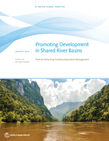Promoting development in shared river basins: tools for enhancing transboundary basin management
 Transboundary freshwater systems create inevitable linkages and interdependencies between countries. The use of shared water resources by one country will, in most cases, impact other countries sharing the same system. At the same time, coordination among countries in the development of transboundary basins can yield greater benefits than would be available to individual countries pursuing individual development. UN Sustainable Development Goal 6 Target 5 recognizes this potential, calling on the world community to implement integrated water resources management at all levels, “including through transboundary cooperation as appropriate.” With a growing number of basins in which water use and demand permanently or temporarily exceeds the amount of renewable water available, and uncertainty from climate change, SDG Target 6.5 becomes increasingly relevant to development interventions designed to secure availability of supplies and create resilience. This study aims to contribute to relevant knowledge for achieving SDG Target 6.5. It identifies an array of tools derived from the international experience that can be used by countries and development partners—distinguishing between tools available to each—in their efforts to develop more water secure economies and societies through harnessing the shared freshwater resources of transboundary basins, while also preventing or mitigating transboundary harm that may otherwise result. The study guides the reader through a three-stage process for choosing the most appropriate tools for the development and management of transboundary freshwater resources.
Transboundary freshwater systems create inevitable linkages and interdependencies between countries. The use of shared water resources by one country will, in most cases, impact other countries sharing the same system. At the same time, coordination among countries in the development of transboundary basins can yield greater benefits than would be available to individual countries pursuing individual development. UN Sustainable Development Goal 6 Target 5 recognizes this potential, calling on the world community to implement integrated water resources management at all levels, “including through transboundary cooperation as appropriate.” With a growing number of basins in which water use and demand permanently or temporarily exceeds the amount of renewable water available, and uncertainty from climate change, SDG Target 6.5 becomes increasingly relevant to development interventions designed to secure availability of supplies and create resilience. This study aims to contribute to relevant knowledge for achieving SDG Target 6.5. It identifies an array of tools derived from the international experience that can be used by countries and development partners—distinguishing between tools available to each—in their efforts to develop more water secure economies and societies through harnessing the shared freshwater resources of transboundary basins, while also preventing or mitigating transboundary harm that may otherwise result. The study guides the reader through a three-stage process for choosing the most appropriate tools for the development and management of transboundary freshwater resources.
